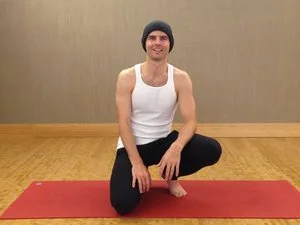I’ve been talking a lot in class this past week about how Samkhya philosophy informs our yoga practice.
Samkhya philosophy is all about numbers. This philosophy is very mathematical and very scientific in how it views the world.
According to Samkhya philosophy -- the world is divided into two things: Consciousness and Nature.
Samkhya calls these two things the Purusha (consciousness) and Prakrti (Nature). It’s important that we understand this because it informs Classical Yoga (the yoga of Patanjali) and our practice of going inward and quieting the mind in meditation, using the tool of Samadhi to achieve deeper states of meditation, and all of the Astanga Yoga preparation practices which encourage single pointed focus for this purpose.
Why do we want to go inward? Yoga and Samkya teach that it is in the stillness where you can experience the pure consciousness part of yourself, the light within you.
According to Samkhya philosophy Nature can further be divided into three original principles, tamas, rajas and sattva. The movement of these three principles is what led to the creation of the universe. Nature in perfect balance was un-manifest.
One way to think of this Samkhya theory is to think of the primary colors. There are only three original colors and these three colors intermingling are able to create every possible color along the color spectrum. Samkhya’s theory is that it’s the same with Nature. There can’t be only two, there would need to be three, and there doesn’t need to be four. With three original principles there can be unlimited combinations, just like with the three primary colors.
The first principle, tamas, means; stillness, inertia, laziness, heaviness, darkness.
The second principle, rajas, means; movement, volition.
The third principle, sattva, means; light, illumination, awareness.
A rock or mountain is very tamasic. A river flowing down that mountain is very rajasic. The sun is very sattvic and illuminates the world.
Think of how these three principles are moving through you as well, to help you better understand them. When tamas is dominating you might feel; lazy, tired, sleepy, heavy, depressed. When rajas is dominating you might feel; impatient, anxious, tense, fidgety, scattered. When sattva is dominating you might feel; light, calm, peaceful, aware.
Concentration in yoga practice brings us into the fire. By concentrating you are wrangling the rajasic energy. There is a battle going on here and that produces intensity, heat, fire, tapas. To find balance in this fire, though, and to go inward, requires the opposite quality of surrender. The action of concentration leads us into the fire. The surrender and letting go while in the fire leads us to the stillness on the other side. By concentrating you are cultivating the active energy of rajas. By surrendering you are cultivating the tamasic energy of stillness. By surrendering while you are concentrating and in the fire you are bringing these two qualities together and this leads to the state of sattva – light, illumination, awareness.
Go through the fire to the other side.
Surrender into the fire and into the stillness beyond.
In the stillness, experience the inner light, pure awareness, pure consciousness.
When you come to my class one of the first things we do is check in to see how we are out of balance at the start of the class. Does the body feel; sleepy, tired, heavy, tamasic? Does the body feel; tight, stressed, fidgety, rajasic? What is dominating? Does the mind feel; sleepy and tired, tamasic? Does the mind feel; scattered, anxious, agitated, rajasic? Where are you starting from? What’s your entry way into your practice?
Think of how your whole yoga practice is like a dance between movement and stillness, rajas and tamas. Think of the dance going on each time you take a breath. The inhale is like rajas and the exhale is like tamas. Is there a moment where they meet? Is there a moment where the inhale has stopped and the exhale hasn’t begun yet? Is there a place where there’s perfect balance between the two? Is there a place where there is sattva?
Think of how your practice is filled with back bending (rajas) and forward folding (tamas) poses. The body opens and closes, opens and closes, over and over again. Is there a place where the two meet? Is there a place of perfect balance between these two? Is there a place where there is sattva?
Can you bring the qualities of rajas and tamas together in perfect balance?
At the end of the practice, in my classes, we always check in to see what has shifted and to see if we are closer to a place of balance from when we started. Hopefully we are closer to balance at the end of the class than we were at the beginning. Is the body more open but also more relaxed? Did you let go of tension in the body but does the body also feel more awake and alive? Is the mind quieter and is there more stillness now but is there also more awareness in the stillness? Does the mind feel sharp, but also open and receptive?
After your practice sit in stillness if you can for as long as possible. Do a seedless meditation. Just witness. There’s no object to concentrate on. Just observe. If anything comes up for you that is distracting try to just let it pass by. Try not to become involved. Just witness. Remain unconcerned. After a while all of the distractions will fade into the background. If your practice has been effective you will slowly dissolve into the stillness and if you go inward deep enough you will experience pure consciousness, pure awareness.
Keep moving towards sattva. It is in sattva that the mind turns inward and we get to experience the light. Bring the two opposites together and find stillness. Go inward. Experience the light of the pure consciousness within you.


